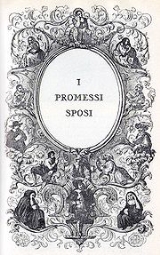
The Betrothed
Encyclopedia
The Betrothed is an Italian
historical novel
by Alessandro Manzoni
, first published in 1827
, in three volumes. It has been called the most famous and widely read novel of the Italian language.
Set in northern Italy
in 1628, during the terrible, oppressive years under Spanish
rule, it is sometimes seen as a veiled attack on Austria
, which controlled the region at the time the novel was written. (The definitive version was published in 1842
). It is also noted for the extraordinary description of the plague that struck Milan around 1630
.
The Betrothed was inspired by Walter Scott
's Ivanhoe
and was the first Italian historical novel. It deals with a variety of themes, from the cowardly, hypocritical nature of a priest (Don Abbondio) and the heroic sainthood of others (Padre Cristoforo, Federico Borromeo
), to the unwavering strength of love
(the relationship between Renzo and Lucia and the struggle of these betrothed to finally meet again and get married), and offers some keen insights into the meanderings of the human mind.
Although not fully appreciated abroad, in Italy the novel is considered a true masterpiece of world literature and a basis for the modern Italian language
, and as such is widely studied in Italian secondary schools (usually in the second year, when students are 15). Many expressions, quotes and names from the novel are still commonly used in Italian, such as Perpetua (meaning a priest's house worker) or Questo matrimonio non s'ha da fare ("This marriage is not to be performed", used ironically).
I promessi sposi was made into an opera of the same name by Amilcare Ponchielli
in 1856 and by Errico Petrella
in 1869. There have been many film versions of I promessi sposi, including I Promessi Sposi, 1908, The Spirit and the Flesh, 1941, The Betrothed, 1990, and Renzo and Lucia, made for TV in 2004.
's Milanese Chronicles.
The first version, Fermo e Lucia, was written between April 1821 and September 1823. It was heavily revised, and finished in August 1825. Corrections and proof-checking took two years. The original title, Gli Sposi Promessi, was changed for the sake of euphony shortly before its publication on 15 June 1827.
In the early 19th century, there was still some controversy as to what form the standard literary language of Italy should take. Manzoni was firmly in favour of the dialect of Florence
and, after washing his vocabulary on the banks of the Arno
(as he put it), he revised the novel for its republication in 1842.
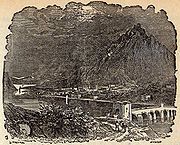 Renzo and Lucia, a couple in an unnamed Lombard
Renzo and Lucia, a couple in an unnamed Lombard
village near Lake Como
, are planning to wed on 8 November 1628. The parish priest, Don Abbondio, is walking home on the previous evening when he is met by a pair of "bravoes
" (thugs) who tell him he is not to perform the marriage, as the local baron (Don Rodrigo) forbids it.
The next day, Renzo is amazed when he turns up at Don Abbondio's home to hear that the marriage is to be postponed (he didn't have the courage to tell the truth). A long argument ensues and Renzo succeeds in extracting from the priest the name of Don Rodrigo. It turns out that Don Rodrigo has his eye on Lucia.
Lucia's mother, Agnese, advises Renzo to ask the advice of "Dr. Azzeccagarbugli" (Dr Quibbleweaver, in Colquhoun's translation), a lawyer in the town of Lecco
. Dr Azzeccagarbugli is at first sympathetic, showing Renzo a recent edict on the subject of priests who refuse to marry, but when he hears the name of Don Rodrigo he panics and drives Renzo away. Lucia sends a message to "Fra Cristoforo" (Friar Christopher), a respected Capuchin
friar at the monastery of Pescarenico, asking him to come as soon as he can.
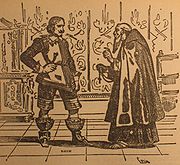 At dawn, Fra Cristoforo comes to Lucia's cottage and hears the story. He immediately leaves for Don Rodrigo's mansion, where he finds the baron at a meal with his cousin Count Attilio, along with four guests, including the mayor and Dr Azzeccagarbugli. When Don Rodrigo is taken aside by the friar, he explodes with anger at his presumption and sends him away, but not before an old servant has a chance to offer him help.
At dawn, Fra Cristoforo comes to Lucia's cottage and hears the story. He immediately leaves for Don Rodrigo's mansion, where he finds the baron at a meal with his cousin Count Attilio, along with four guests, including the mayor and Dr Azzeccagarbugli. When Don Rodrigo is taken aside by the friar, he explodes with anger at his presumption and sends him away, but not before an old servant has a chance to offer him help.
Meanwhile, Agnese comes up with a plan. In those days, it was possible for two people to marry by declaring themselves married before a priest and in the presence of two amenable witnesses. Renzo runs to his friend Tonio and offers him 25 lire if he agrees to help. When Fra Cristoforo returns with the bad news, they decide to put their plan into action.
The next morning, Lucia and Agnese are visited by beggars who are, in fact, Don Rodrigo's men in disguise. They are examining the house in order to plan an assault. Late at night, Agnese distracts the servant Perpetua while Tonio and his brother Gervaso enter Don Abbondio's study, ostensibly to pay a debt. They are followed indoors secretly by Lucia and Renzo. When they try to carry out their plan, the priest throws the tablecloth in Lucia's face and drops the lamp. They struggle in the darkness.
In the meantime, Don Rodrigo's men invade Lucia's house, but nobody is there. A boy named Menico arrives with a message of warning from Fra Cristoforo and they seize him. When they hear the alarm being raised by the sacristan, they assume they have been betrayed and flee in confusion. Menico sees Agnese, Lucia and Renzo in the street and warns them not to return home. They go to the monastery, where Fra Cristoforo gives Renzo a letter of introduction to a certain friar at Milan
, and another letter to the two women, to organise a refuge at a convent in the nearby city of Monza
.
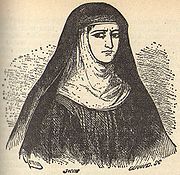 Lucia is entrusted to the nun Gertrude, a strange and unpredictable noblewoman whose story is told in these chapters.
Lucia is entrusted to the nun Gertrude, a strange and unpredictable noblewoman whose story is told in these chapters.
A child of the most important family of the area, her father decided to send her to the cloisters for no other reason than to simplify his affairs: he wished to keep his properties united for his first-born, heir to the family's title and riches. As she grew up, she sensed that she was being forced by her parents into a life which would comport but little with her personality. However, fear of scandal, as well as manoeuvres and menaces from her father, induced Gertrude to lie to her interviewers in order to enter the convent of Monza
, where she was received as la Signora ("the lady"). Later, she fell under the spell of a young man of no scruples, associated with the worst baron of that time, the Innominato (the Unnamed).
 Renzo arrives in famine-stricken Milan and goes to the monastery, but the friar he is seeking is absent and so he wanders further into the city. A bakery in the Corsia de' Servi, El prestin di scansc ("Bakery of the Crutches"), is destroyed by a rabble, which then goes to the house of the Commissioner of Supply in order to lynch him. He is saved in the nick of time by Ferrer, the Grand Chancellor, who arrives in a coach and announces he is taking the Commissioner to prison. Renzo becomes prominent as he helps Ferrer make his way through the crowd.
Renzo arrives in famine-stricken Milan and goes to the monastery, but the friar he is seeking is absent and so he wanders further into the city. A bakery in the Corsia de' Servi, El prestin di scansc ("Bakery of the Crutches"), is destroyed by a rabble, which then goes to the house of the Commissioner of Supply in order to lynch him. He is saved in the nick of time by Ferrer, the Grand Chancellor, who arrives in a coach and announces he is taking the Commissioner to prison. Renzo becomes prominent as he helps Ferrer make his way through the crowd.
After witnessing these scenes, Renzo joins in a lively discussion and reveals views which attract the notice of a police agent in search of a scapegoat. The agent tries to lead Renzo directly to "the best inn" (i.e. prison) but Renzo is tired and stops at one nearby where, after being plied with drink, he reveals his full name and address. The next morning, he is awakened by a notary and two bailiffs, who handcuff him and start to take him away. In the street Renzo announces loudly that he is being punished for his heroism the day before and, with the aid of sympathetic onlookers, he effects his escape. Leaving the city by the same gate through which he entered, he sets off for Bergamo
, knowing that his cousin Bortolo lives in a village nearby. Once there, he will be beyond the reach of the authorities of Milan (under Spanish domination), as Bergamo is territory of the Most Serene Republic of Venice
.
At an inn in Gorgonzola
, he overhears a conversation which makes it clear to him how much trouble he is in and so he walks all night until he reaches the River Adda
. After a short sleep in a hut, he crosses the river at dawn in the boat of a fisherman and makes his way to his cousin's house, where he is welcomed as a silk-weaver under the pseudonym of Antonio Rivolta. The same day, orders for Renzo's arrest reach the town of Lecco
, to the delight of Don Rodrigo.
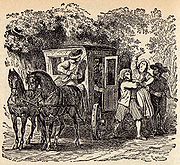 News of Renzo's disgrace comes to the convent, but later Lucia is informed that Renzo is safe with his cousin. Their reassurance is short-lived: when they receive no word from Fra Cristoforo for a long time, Agnese travels to Pescarenico, where she learns that he has been ordered by a superior to the town of Rimini. In fact, this has been engineered by Don Rodrigo and Count Attilio, who have leaned on a mutual uncle of the Secret Council, who has leaned on the Father Provincial. Meanwhile, Don Rodrigo has organised a plot to kidnap Lucia from the convent. This involves a very great robber baron whose name has not been recorded, and who hence is called l'Innominato, the Unnamed.
News of Renzo's disgrace comes to the convent, but later Lucia is informed that Renzo is safe with his cousin. Their reassurance is short-lived: when they receive no word from Fra Cristoforo for a long time, Agnese travels to Pescarenico, where she learns that he has been ordered by a superior to the town of Rimini. In fact, this has been engineered by Don Rodrigo and Count Attilio, who have leaned on a mutual uncle of the Secret Council, who has leaned on the Father Provincial. Meanwhile, Don Rodrigo has organised a plot to kidnap Lucia from the convent. This involves a very great robber baron whose name has not been recorded, and who hence is called l'Innominato, the Unnamed.
Gertrude, blackmailed by Egidio, a male neighbour (and acquaintance of l'Innominato) whose attentions she has returned, persuades Lucia to run an errand which will take her outside the convent for a short while. In the street Lucia is seized and bundled into a coach. After a nightmarish journey, Lucia arrives at the castle of the Unnamed, where she is locked up in a chamber.
 The Unnamed is troubled by the sight of her, and spends a horrible night in which memories of his past and the uncertainty of his future almost drive him to suicide. Meanwhile, Lucia spends a similarly restless night, during which she vows to take the veil if she is delivered from her predicament. Towards the morning, on looking out of his window, the Unnamed sees throngs of people walking past. They are going to listen to the famous Archbishop of Milan, Cardinal Federigo Borromeo. On impulse, the Unnamed leaves his castle in order to meet this man. This meeting prompts a "miraculous" conversion which marks the turning-point of the novel. The Unnamed announces to his men that his reign of terror is over. He decides to take Lucia back to her native land under his own protection, and with the help of the archbishop the deed is done.
The Unnamed is troubled by the sight of her, and spends a horrible night in which memories of his past and the uncertainty of his future almost drive him to suicide. Meanwhile, Lucia spends a similarly restless night, during which she vows to take the veil if she is delivered from her predicament. Towards the morning, on looking out of his window, the Unnamed sees throngs of people walking past. They are going to listen to the famous Archbishop of Milan, Cardinal Federigo Borromeo. On impulse, the Unnamed leaves his castle in order to meet this man. This meeting prompts a "miraculous" conversion which marks the turning-point of the novel. The Unnamed announces to his men that his reign of terror is over. He decides to take Lucia back to her native land under his own protection, and with the help of the archbishop the deed is done.
Lucia, miserable about her vow to renounce Renzo, still frets about him. He is now the subject of diplomatic conflict between Milan and Bergamo. Her life is not improved when a wealthy busybody, Donna Prassede, insists on taking her into her household and admonishing her for getting mixed up with a good-for-nothing like Renzo.
Meanwhile the Thirty Years War brings more calamities. In September 1629, German armies under Count Rambaldo di Collalto
descend into Italy, looting and destroying. Agnese, Don Abbondio and Perpetua take refuge in the well-defended territory of the Unnamed. In their absence, their village is wrecked by the mercenaries.
's De peste quae fuit anno 1630 (published in 1640). Manzoni's full version of this, Storia della Colonna Infame, was finished in 1829, but was not published until it was included as an appendix to the revised edition of 1842.
The end of August 1630 sees the death in Milan of the original villains of the story. Renzo, troubled by Agnese's letters and recovering from plague, returns to his native village to find that many of the inhabitants are dead and that his house and vineyard have been destroyed. The warrant, and Don Rodrigo, are forgotten. Tonio tells him that Lucia is in Milan.
But in fact, Lucia is already recuperating. Renzo and Lucia are reunited by Fra Cristoforo, but only after Renzo first visits and forgives the dying Don Rodrigo. The friar absolves her of her vow of celibacy. Renzo walks through a rainstorm to see Agnese at the village of Pasturo. When they all return to their native village, Lucia and Renzo are finally married by Don Abbondio and the couple make a fresh start at a silk-mill at the gates of Bergamo.
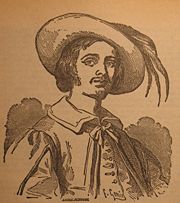
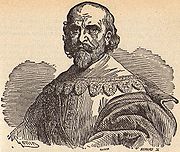
Italian language
Italian is a Romance language spoken mainly in Europe: Italy, Switzerland, San Marino, Vatican City, by minorities in Malta, Monaco, Croatia, Slovenia, France, Libya, Eritrea, and Somalia, and by immigrant communities in the Americas and Australia...
historical novel
Historical novel
According to Encyclopædia Britannica, a historical novel is-Development:An early example of historical prose fiction is Luó Guànzhōng's 14th century Romance of the Three Kingdoms, which covers one of the most important periods of Chinese history and left a lasting impact on Chinese culture.The...
by Alessandro Manzoni
Alessandro Manzoni
Alessandro Francesco Tommaso Manzoni was an Italian poet and novelist.He is famous for the novel The Betrothed , generally ranked among the masterpieces of world literature...
, first published in 1827
1827 in literature
The year 1827 in literature involved some significant events and new books.-Events:* Samuel G. Goodrich publishes the first of the "Peter Parley" juvenile novels that would continue until 1860....
, in three volumes. It has been called the most famous and widely read novel of the Italian language.
Set in northern Italy
Italy
Italy , officially the Italian Republic languages]] under the European Charter for Regional or Minority Languages. In each of these, Italy's official name is as follows:;;;;;;;;), is a unitary parliamentary republic in South-Central Europe. To the north it borders France, Switzerland, Austria and...
in 1628, during the terrible, oppressive years under Spanish
Spain
Spain , officially the Kingdom of Spain languages]] under the European Charter for Regional or Minority Languages. In each of these, Spain's official name is as follows:;;;;;;), is a country and member state of the European Union located in southwestern Europe on the Iberian Peninsula...
rule, it is sometimes seen as a veiled attack on Austria
Austria
Austria , officially the Republic of Austria , is a landlocked country of roughly 8.4 million people in Central Europe. It is bordered by the Czech Republic and Germany to the north, Slovakia and Hungary to the east, Slovenia and Italy to the south, and Switzerland and Liechtenstein to the...
, which controlled the region at the time the novel was written. (The definitive version was published in 1842
1842 in literature
The year 1842 in literature involved some significant new books.-Events:*Fanny Burney's diary and letters are posthumously published.*The Book of Abraham is published in two installments in the Times and Seasons....
). It is also noted for the extraordinary description of the plague that struck Milan around 1630
Italian Plague of 1629-1631
The Italian Plague of 1629–1631 was a series of outbreaks of bubonic plague which occurred from 1629 through 1631 in northern Italy. This epidemic, often referred to as Great Plague of Milan, claimed the lives of approximately 280,000 people, with the cities of the Lombardy and Veneto regions...
.
The Betrothed was inspired by Walter Scott
Walter Scott
Sir Walter Scott, 1st Baronet was a Scottish historical novelist, playwright, and poet, popular throughout much of the world during his time....
's Ivanhoe
Ivanhoe
Ivanhoe is a historical fiction novel by Sir Walter Scott in 1819, and set in 12th-century England. Ivanhoe is sometimes credited for increasing interest in Romanticism and Medievalism; John Henry Newman claimed Scott "had first turned men's minds in the direction of the middle ages," while...
and was the first Italian historical novel. It deals with a variety of themes, from the cowardly, hypocritical nature of a priest (Don Abbondio) and the heroic sainthood of others (Padre Cristoforo, Federico Borromeo
Federico Borromeo
Federico Borromeo was an Italian ecclesiastic, cardinal and archbishop of Milan.-Biography:Federico Borromeo was born in Milan as the second son of Giulio Cesare Borromeo, Count of Arona, and Margherita Trivulzio...
), to the unwavering strength of love
Love
Love is an emotion of strong affection and personal attachment. In philosophical context, love is a virtue representing all of human kindness, compassion, and affection. Love is central to many religions, as in the Christian phrase, "God is love" or Agape in the Canonical gospels...
(the relationship between Renzo and Lucia and the struggle of these betrothed to finally meet again and get married), and offers some keen insights into the meanderings of the human mind.
Although not fully appreciated abroad, in Italy the novel is considered a true masterpiece of world literature and a basis for the modern Italian language
Italian language
Italian is a Romance language spoken mainly in Europe: Italy, Switzerland, San Marino, Vatican City, by minorities in Malta, Monaco, Croatia, Slovenia, France, Libya, Eritrea, and Somalia, and by immigrant communities in the Americas and Australia...
, and as such is widely studied in Italian secondary schools (usually in the second year, when students are 15). Many expressions, quotes and names from the novel are still commonly used in Italian, such as Perpetua (meaning a priest's house worker) or Questo matrimonio non s'ha da fare ("This marriage is not to be performed", used ironically).
I promessi sposi was made into an opera of the same name by Amilcare Ponchielli
Amilcare Ponchielli
Amilcare Ponchielli was an Italian composer, largely of operas.-Biography:Born in Paderno Fasolaro, now Paderno Ponchielli, near Cremona, Ponchielli won a scholarship at the age of nine to study music at the Milan Conservatory, writing his first symphony by the time he was ten years old.Two years...
in 1856 and by Errico Petrella
Errico Petrella
Errico Petrella was an Italian opera composer.Petrella was born at Palermo. A conservative of the Neapolitan school, he was the most successful Italian composer, second only to Verdi, during the 1850s and 1860s. He also earned the latter's scorn for his compositional and dramatic crudities,...
in 1869. There have been many film versions of I promessi sposi, including I Promessi Sposi, 1908, The Spirit and the Flesh, 1941, The Betrothed, 1990, and Renzo and Lucia, made for TV in 2004.
Writing and publication
The idea for the novel came to Manzoni in 1821, from something he saw in a book he took on holiday with him to Brusuglio. This was an edict from the year 1627 (reprinted in Melchiorre Gioia's Economia e Statistica), which specified penalties for any priest who refused to perform a marriage. More material came from Giuseppe RipamontiGiuseppe Ripamonti
Giuseppe Ripamonti was an Italian historian.Ripamonti was born in Colle Brianza, and became a Doctor of Biblioteca Ambrosiana in Milan....
's Milanese Chronicles.
The first version, Fermo e Lucia, was written between April 1821 and September 1823. It was heavily revised, and finished in August 1825. Corrections and proof-checking took two years. The original title, Gli Sposi Promessi, was changed for the sake of euphony shortly before its publication on 15 June 1827.
In the early 19th century, there was still some controversy as to what form the standard literary language of Italy should take. Manzoni was firmly in favour of the dialect of Florence
Florence
Florence is the capital city of the Italian region of Tuscany and of the province of Florence. It is the most populous city in Tuscany, with approximately 370,000 inhabitants, expanding to over 1.5 million in the metropolitan area....
and, after washing his vocabulary on the banks of the Arno
Arno
The Arno is a river in the Tuscany region of Italy. It is the most important river of central Italy after the Tiber.- Source and route :The river originates on Mount Falterona in the Casentino area of the Apennines, and initially takes a southward curve...
(as he put it), he revised the novel for its republication in 1842.
Chapters 1-8: Flight from the village

Lombardy
Lombardy is one of the 20 regions of Italy. The capital is Milan. One-sixth of Italy's population lives in Lombardy and about one fifth of Italy's GDP is produced in this region, making it the most populous and richest region in the country and one of the richest in the whole of Europe...
village near Lake Como
Lake Como
Lake Como is a lake of glacial origin in Lombardy, Italy. It has an area of 146 km², making it the third largest lake in Italy, after Lake Garda and Lake Maggiore...
, are planning to wed on 8 November 1628. The parish priest, Don Abbondio, is walking home on the previous evening when he is met by a pair of "bravoes
Bravi
Bravi were a species of coarse soldiery employed by the rural lordlings of northern Italy in the sixteenth and seventeenth centuries to protect their interests...
" (thugs) who tell him he is not to perform the marriage, as the local baron (Don Rodrigo) forbids it.
The next day, Renzo is amazed when he turns up at Don Abbondio's home to hear that the marriage is to be postponed (he didn't have the courage to tell the truth). A long argument ensues and Renzo succeeds in extracting from the priest the name of Don Rodrigo. It turns out that Don Rodrigo has his eye on Lucia.
Lucia's mother, Agnese, advises Renzo to ask the advice of "Dr. Azzeccagarbugli" (Dr Quibbleweaver, in Colquhoun's translation), a lawyer in the town of Lecco
Lecco
Lecco is a town of c. 47,760 inhabitants in Lombardy, northern Italy, north of Milan, the capital of the province of Lecco. It lies at the end of the south-eastern branch of Lake Como...
. Dr Azzeccagarbugli is at first sympathetic, showing Renzo a recent edict on the subject of priests who refuse to marry, but when he hears the name of Don Rodrigo he panics and drives Renzo away. Lucia sends a message to "Fra Cristoforo" (Friar Christopher), a respected Capuchin
Order of Friars Minor Capuchin
The Order of Friars Minor Capuchin is an Order of friars in the Catholic Church, among the chief offshoots of the Franciscans. The worldwide head of the Order, called the Minister General, is currently Father Mauro Jöhri.-Origins :...
friar at the monastery of Pescarenico, asking him to come as soon as he can.

Meanwhile, Agnese comes up with a plan. In those days, it was possible for two people to marry by declaring themselves married before a priest and in the presence of two amenable witnesses. Renzo runs to his friend Tonio and offers him 25 lire if he agrees to help. When Fra Cristoforo returns with the bad news, they decide to put their plan into action.
The next morning, Lucia and Agnese are visited by beggars who are, in fact, Don Rodrigo's men in disguise. They are examining the house in order to plan an assault. Late at night, Agnese distracts the servant Perpetua while Tonio and his brother Gervaso enter Don Abbondio's study, ostensibly to pay a debt. They are followed indoors secretly by Lucia and Renzo. When they try to carry out their plan, the priest throws the tablecloth in Lucia's face and drops the lamp. They struggle in the darkness.
In the meantime, Don Rodrigo's men invade Lucia's house, but nobody is there. A boy named Menico arrives with a message of warning from Fra Cristoforo and they seize him. When they hear the alarm being raised by the sacristan, they assume they have been betrayed and flee in confusion. Menico sees Agnese, Lucia and Renzo in the street and warns them not to return home. They go to the monastery, where Fra Cristoforo gives Renzo a letter of introduction to a certain friar at Milan
Milan
Milan is the second-largest city in Italy and the capital city of the region of Lombardy and of the province of Milan. The city proper has a population of about 1.3 million, while its urban area, roughly coinciding with its administrative province and the bordering Province of Monza and Brianza ,...
, and another letter to the two women, to organise a refuge at a convent in the nearby city of Monza
Monza
Monza is a city and comune on the river Lambro, a tributary of the Po, in the Lombardy region of Italy some 15 km north-northeast of Milan. It is the capital of the Province of Monza and Brianza. It is best known for its Grand Prix motor racing circuit, the Autodromo Nazionale Monza.On June...
.
Chapters 9-10: the Nun of Monza

A child of the most important family of the area, her father decided to send her to the cloisters for no other reason than to simplify his affairs: he wished to keep his properties united for his first-born, heir to the family's title and riches. As she grew up, she sensed that she was being forced by her parents into a life which would comport but little with her personality. However, fear of scandal, as well as manoeuvres and menaces from her father, induced Gertrude to lie to her interviewers in order to enter the convent of Monza
Monza
Monza is a city and comune on the river Lambro, a tributary of the Po, in the Lombardy region of Italy some 15 km north-northeast of Milan. It is the capital of the Province of Monza and Brianza. It is best known for its Grand Prix motor racing circuit, the Autodromo Nazionale Monza.On June...
, where she was received as la Signora ("the lady"). Later, she fell under the spell of a young man of no scruples, associated with the worst baron of that time, the Innominato (the Unnamed).
Chapters 11-17: Renzo in Milan

After witnessing these scenes, Renzo joins in a lively discussion and reveals views which attract the notice of a police agent in search of a scapegoat. The agent tries to lead Renzo directly to "the best inn" (i.e. prison) but Renzo is tired and stops at one nearby where, after being plied with drink, he reveals his full name and address. The next morning, he is awakened by a notary and two bailiffs, who handcuff him and start to take him away. In the street Renzo announces loudly that he is being punished for his heroism the day before and, with the aid of sympathetic onlookers, he effects his escape. Leaving the city by the same gate through which he entered, he sets off for Bergamo
Bergamo
Bergamo is a town and comune in Lombardy, Italy, about 40 km northeast of Milan. The comune is home to over 120,000 inhabitants. It is served by the Orio al Serio Airport, which also serves the Province of Bergamo, and to a lesser extent the metropolitan area of Milan...
, knowing that his cousin Bortolo lives in a village nearby. Once there, he will be beyond the reach of the authorities of Milan (under Spanish domination), as Bergamo is territory of the Most Serene Republic of Venice
Venice
Venice is a city in northern Italy which is renowned for the beauty of its setting, its architecture and its artworks. It is the capital of the Veneto region...
.
At an inn in Gorgonzola
Gorgonzola
Gorgonzola is a comune in the province of Milan, part of Lombardy, northern Italy. Once a rural community, and famous for the cheese which bears its name, today it forms part of the Milanese conurbation and has three stops on the Milan Metro.- History :...
, he overhears a conversation which makes it clear to him how much trouble he is in and so he walks all night until he reaches the River Adda
Adda River
The Adda is a river in North Italy, a tributary of the Po. It rises in the Alps near the border with Switzerland and flows through Lake Como. The Adda joins the Po a few kilometres upstream of Cremona. It is 313 kilometres long...
. After a short sleep in a hut, he crosses the river at dawn in the boat of a fisherman and makes his way to his cousin's house, where he is welcomed as a silk-weaver under the pseudonym of Antonio Rivolta. The same day, orders for Renzo's arrest reach the town of Lecco
Lecco
Lecco is a town of c. 47,760 inhabitants in Lombardy, northern Italy, north of Milan, the capital of the province of Lecco. It lies at the end of the south-eastern branch of Lake Como...
, to the delight of Don Rodrigo.
Chapters 18-24: Lucia and the Unnamed

Gertrude, blackmailed by Egidio, a male neighbour (and acquaintance of l'Innominato) whose attentions she has returned, persuades Lucia to run an errand which will take her outside the convent for a short while. In the street Lucia is seized and bundled into a coach. After a nightmarish journey, Lucia arrives at the castle of the Unnamed, where she is locked up in a chamber.

Chapters 25-27: Fall of Don Rodrigo
The astonishing course of events leads to an atmosphere in which Don Rodrigo can be defied openly and his fortunes take a turn for the worse. Don Abbondio is reprimanded by the archbishop.Lucia, miserable about her vow to renounce Renzo, still frets about him. He is now the subject of diplomatic conflict between Milan and Bergamo. Her life is not improved when a wealthy busybody, Donna Prassede, insists on taking her into her household and admonishing her for getting mixed up with a good-for-nothing like Renzo.
Chapters 28-30: Famine and War
The government of Milan is unable to keep bread prices down by decree and the city is swamped by beggars. The lazzaretto is filled with the hungry and sick.Meanwhile the Thirty Years War brings more calamities. In September 1629, German armies under Count Rambaldo di Collalto
Ramboldo, Count of Collalto
Ramboldo XIII, Count of Collalto was an Italian Imperial commander.-Biography:Born at Mantua into an ancient noble Venetian family , dating back to the 10th century, he was the son of Venetian general Antonio IV of Collalto. Expelled from the Republic of Venice, he joined the Imperial Army and...
descend into Italy, looting and destroying. Agnese, Don Abbondio and Perpetua take refuge in the well-defended territory of the Unnamed. In their absence, their village is wrecked by the mercenaries.
Chapters 31-33: Plague
These chapters are occupied with an account of the plague of 1630, largely based on Giuseppe RipamontiGiuseppe Ripamonti
Giuseppe Ripamonti was an Italian historian.Ripamonti was born in Colle Brianza, and became a Doctor of Biblioteca Ambrosiana in Milan....
's De peste quae fuit anno 1630 (published in 1640). Manzoni's full version of this, Storia della Colonna Infame, was finished in 1829, but was not published until it was included as an appendix to the revised edition of 1842.
The end of August 1630 sees the death in Milan of the original villains of the story. Renzo, troubled by Agnese's letters and recovering from plague, returns to his native village to find that many of the inhabitants are dead and that his house and vineyard have been destroyed. The warrant, and Don Rodrigo, are forgotten. Tonio tells him that Lucia is in Milan.
Chapters 34-38: Conclusion
On his arrival in Milan, Renzo is astonished at the state of the city. His highland clothes invite suspicion that he is an "anointer"; that is, a foreign agent deliberately spreading plague in some way. He learns that Lucia is now languishing at the lazzaretto, along with 16,000 other victims of the plague.But in fact, Lucia is already recuperating. Renzo and Lucia are reunited by Fra Cristoforo, but only after Renzo first visits and forgives the dying Don Rodrigo. The friar absolves her of her vow of celibacy. Renzo walks through a rainstorm to see Agnese at the village of Pasturo. When they all return to their native village, Lucia and Renzo are finally married by Don Abbondio and the couple make a fresh start at a silk-mill at the gates of Bergamo.
Characters

- Lorenzo Tramaglino, or in short form Renzo is a young silk-weaver of humble origins, engaged to Lucia, whom he loves deeply. Initially rather naive, he becomes more cunning throughout the novel as he is confronted with many difficulties: he is separated from Lucia and then unjustly accused of being a criminal. Renzo is somewhat short-tempered, but also gentle and honest.
- Lucia Mondella is a pious and kind young woman who loves Renzo. She is forced to flee from her village to escape from Don Rodrigo in one of the most famous scenes of Italian literature, the Addio ai Monti or "Farewell to the mountains."
- Don Abbondio is the priest who refuses to marry Renzo and Lucia because he has been threatened by Don Rodrigo's men; he meets the two protagonists several times during the novel. The cowardly, morally mediocre Don Abbondio provides most of the book's comic reliefComic reliefComic relief is the inclusion of a humorous character, scene or witty dialogue in an otherwise serious work, often to relieve tension.-Definition:...
; however, he is not merely a stock characterStock characterA Stock character is a fictional character based on a common literary or social stereotype. Stock characters rely heavily on cultural types or names for their personality, manner of speech, and other characteristics. In their most general form, stock characters are related to literary archetypes,...
, as his moral failings are portrayed by Manzoni with a mixture of irony, sadness and pity, as has been noted by Luigi PirandelloLuigi PirandelloLuigi Pirandello was an Italian dramatist, novelist, and short story writer awarded the Nobel Prize in Literature in 1934, for his "bold and brilliant renovation of the drama and the stage." Pirandello's works include novels, hundreds of short stories, and about 40 plays, some of which are written...
in his essay "On Humour" (Saggio sull'Umorismo). - Fra Cristoforo is a brave and generous friar who helps Renzo and Lucia, acting as a sort of "father figure" to both and as the moral compass of the novel. Fra Cristoforo was the son of a wealthy family, and joined the Capuchin Order after killing a man.
- Don Rodrigo is a cruel and despicable nobleman and the novel's main villain. He decides to prevent with the force Renzo and Lucia's marriage, threatens to kill Don Abbondio if he marries the two and tries to kidnap Lucia.

- L'Innominato (literally: the Unnamed) is probably the novel's most complex character, a powerful and feared criminal who is torn between his ferocious past and the increasing disgust he feels for his life. Based on the historical character of Francesco Bernardino Visconti, who was really converted by a visit of Federico Borromeo.
- Agnese Mondella is Lucia's wise mother.
- Federico Borromeo (Federigo in the book) is a virtuous and zealous cardinal. Historical characterFederico BorromeoFederico Borromeo was an Italian ecclesiastic, cardinal and archbishop of Milan.-Biography:Federico Borromeo was born in Milan as the second son of Giulio Cesare Borromeo, Count of Arona, and Margherita Trivulzio...
. - Perpetua is Don Abbondio's loquacious servant.
- La Monaca di Monza (the Nun of Monza) is a tragic figure, a bitter, frustrated, sexually deprived and ambiguous woman. She befriends Lucia and becomes genuinely fond of her, but her dark past still haunts her. Based on a historical character.
- Griso is one of Don Rodrigo's henchmen, a silent and traitorous man.
- Dr Azzecca-garbugli ("Quibble-weaver") is a corrupt lawyer.
- Count Attilio is Don Rodrigo's malevolent cousin.
- Nibbio (Kite - the bird) is the Innominato's right-hand man.
- Don Ferrante is a phony intellectual and erudite scholar who believes the plague is caused by astrological forces.
- Donna Prassede is Don Ferrante's wife, who is willing to help Lucia but is also an opinionated busybody.
English translations
- The Betrothed Lovers (1828), by Rev. Charles Swan, published at Pisa
- Three new translations (1834), one of them printed in New York under the title Lucia, The Betrothed.
- Two new translations (1844, 1845); the 1844 translation was the one most reprinted in the 19th century
- The Betrothed (1924), by Daniel J. Connor
- The Betrothed (1951), by Archibald Colquhoun
- The Betrothed (1972), by Bruce Penman, Penguin Books, ISBN 0-140-44274-X
External links
- A review of The Betrothed written by Edgar Allan Poe in 1835 and published in the Southern Literary Messenger.
- Audiobook -- complete reading—MP3 Creative Commons
- English translation of The Betrothed
- Complete Italian text of I Promessi Sposi
- The Betrothed Map

